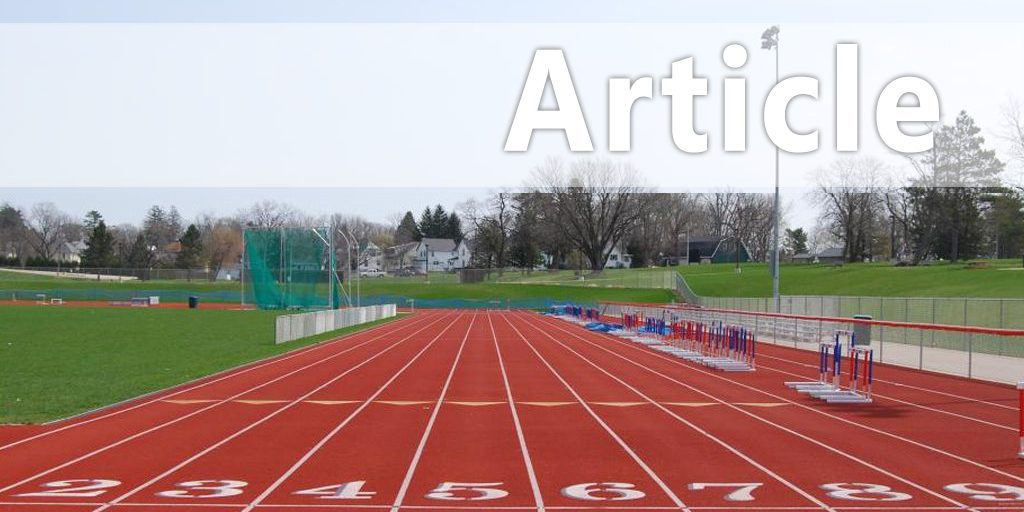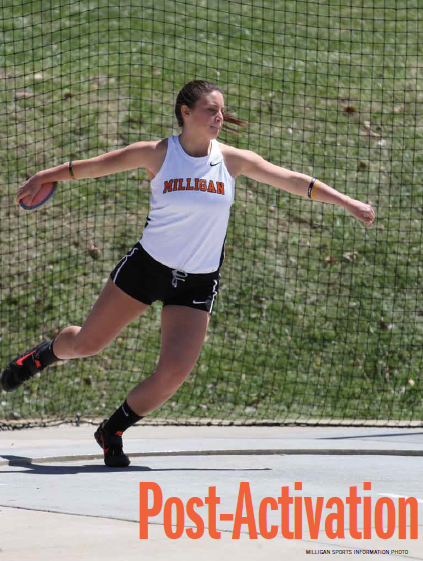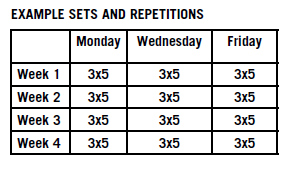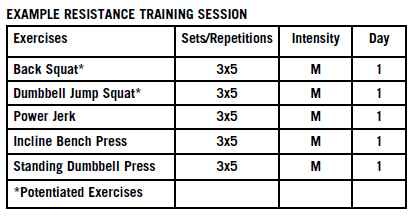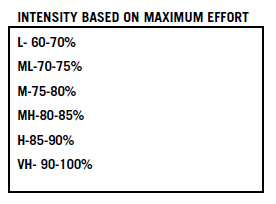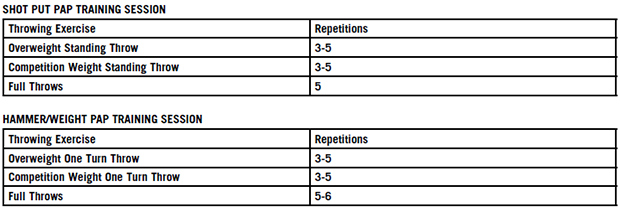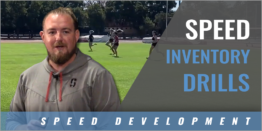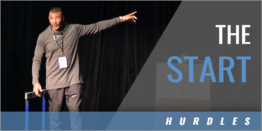|
Post-Activation Potentiation By: Daniel Corriher Originally Published in Techniques Magazine - Provided by: USTFCCCA
The five throwing events in collegiate track and field demand the athletes to have considerable amounts of strength and power production. The use of post- activation potentiation (PAP) is a well-known method used within training, ranging from exercise selection to timing methods. The purpose of this article is to define PAP, how it can best be utilized and, most importantly, give the throws coach scientific training tools to increase performance. POST-ACTIVATION POTENTIATION IMPLEMENTING PAP IN A TRAINING PROGRAM Various weight lifting movements produce high levels of power output and RFD. Some examples are the back squat, clean and jerk, and the snatch (Stone et. al., 2003), (Adams, O'Shea, O'Shea & C,limstein, 1992), (Mcbride, Nimphius, & Erickson, 2005). These exercises can be used to potentiate each other to create a greater result within the training session. Additionally, improvement in these lifts will aid the thrower. An example of this is to potentiate back squats by performing jerks (split or power) prior to the set. Coaches can also implement movements that are more specific to the actual throw within the weight room. Performing heavy medicine ball throws on an incline bench prior to performing an incline bench can be very specific to shot put throwing. The athlete needs to be in a similar angle to the finish of the shot put when on the incline bench for both exercises to achieve specificity. The most commonly known form of PAP for throwing is performing throws with heavier implements before throwing the competition weight. Novice to moderately trained athletes should not advance much farther than the standing throw due to strength and technical deficiencies. When PAP is used within throwing sessions, the coach should not use too much weight for the implements. An addition of 1-2 kilograms for the implement weight should be adequate to achieve PAP. Another method to achieve potentiation within a throwing session is to use medicine balls before performing a throw. An example of this is having the athlete toss the medicine ball explosively for height for a set followed by a throw. The combination of potentiating a throws session with the weight room can produce improved results as well. This last method to achieve PAP can be time consuming and limited due to proximity of the weight room and throwing circle. The weight lifting movements beneficial to throwers in weight training can be used in this combined methodology Using this combination of throws and weight training can become specific by having the thrower perform weight lifting movements before throwing. For example, a hammer thrower would do a set of snatches from the mid-thigh position prior to throwing the hammer. The similarities between the hang snatch and releasing the hammer are similar; therefore, you can get a specific movement involved while creating a potentiated effect. Another example would be performing squat jumps prior to doing any of the throws. This movement is specific due to the use of the legs within the finish of a throw. PRACTICAL APPLICATIONS
REFERENCES 1) Adams, K, O'Shea, J. P., O'Shea, K L., & Climstein, M (1992). The effect of six weeks of squat, plyometric and squat-plyometric training on power production.Journal of Applied Sport Science Research, 6(1), 36-41. 2) Bompa, T. 0., & Haft; G. G. (2009). Periodization: Theory and meth-odology of training. (5th ed.). Champaign: Human Kinetics. 3) Judge, L. W, Bellar, D. M, Judge, M, Gilreath, E., Bodey, K J., & Simon, L. (2012). Efficacy of potentiation of performance through over weight implement throws on female shot putters. Track and Cross Country Journal, 1(4), 7-14. 4) McBride, J. M, Nimphius, S., & Erickson, T. M (2005). The acute effects of heavy-load squats and loaded countermovement jumps on sprint performance.Journal of Strength and Conditioning Research,19(4), 893-897. 5) Stone, M H., Sanborn, K, O'Bryant, H. S., Hartman, M, Stone, M E., Chris, P., Ward, B., & Hruby, J. (2003). Maximum strength-power-performance relationships in collegiate throwers. Journal of Strength and Conditioning Research, 17(4), 739-745. 6) Stone, M H., Stone, M E., & Sands, W. A. (2007).Principles and practice of resistance training. Champaign: Human Kinetics. 7) Judge, LW. (2009). The application of post-activation potentiation to the track and field thrower. Strength & Conditioning Journal 31(3): 34-36.
Daniel Corriher is an Assistant Track & Field coach at Milligan College in Tennessee.
|



